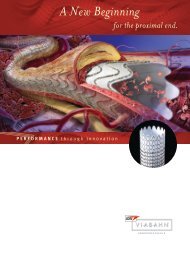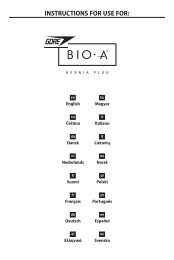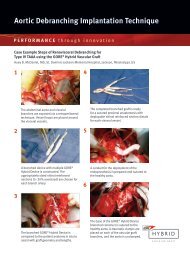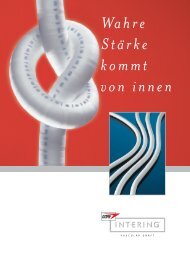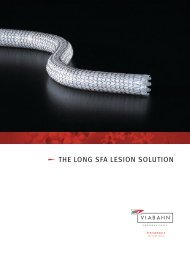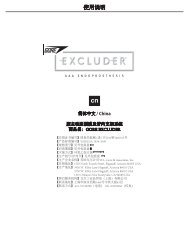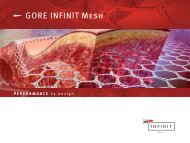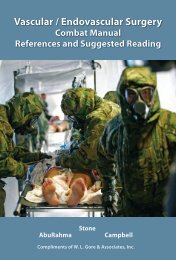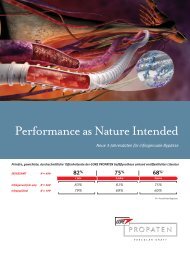Instructions for Use - Multilingual - Gore Medical
Instructions for Use - Multilingual - Gore Medical
Instructions for Use - Multilingual - Gore Medical
Create successful ePaper yourself
Turn your PDF publications into a flip-book with our unique Google optimized e-Paper software.
For each vascular device and assembly, the artifacts may<br />
appear on MR images as localized signal voids (i.e., signal<br />
loss) that are minor in size relative to the size and shape<br />
of these implants. The gradient echo pulse sequence may<br />
produce larger artifacts than the T1 – weighted, spin echo<br />
pulse sequence <strong>for</strong> the GORE® Hybrid Vascular Graft. MR<br />
image quality may be compromised if the area of interest is in<br />
the exact same area or relatively close to the position of the<br />
nitinol rein<strong>for</strong>ced section of the GORE® Hybrid Vascular Graft.<br />
There<strong>for</strong>e, it may be necessary to optimize the MR imaging<br />
parameters to compensate <strong>for</strong> the presence of this implant.<br />
VI. POSSIBLE COMPLICATIONS WITH THE USE OF<br />
ANY VASCULAR PROSTHESIS<br />
A. Complications which may occur in conjunction with the<br />
use of any vascular prosthesis include but are not limited<br />
to: redundancy; infection; ultrafiltration or perigraft<br />
seroma; thrombosis; mechanical disruption or tearing<br />
of the suture line, graft, and / or host vessel; excessive<br />
suture hole bleeding; <strong>for</strong>mation of pseudoaneurysms<br />
due to excessive, localized, or large needle punctures; or<br />
perigraft hematomas.<br />
B. Complications and adverse events can occur when using<br />
any device that utilizes nitinol. These complications<br />
include, but are not limited to: hematoma; stenosis,<br />
thrombosis or occlusion; distal embolism; side branch<br />
occlusion; vessel wall trauma and / or rupture; false<br />
aneurysm; infection; inflammation; fever and / or pain in<br />
the absence of infection; deployment failure; migration;<br />
and device failure.<br />
C. A possible complication which may occur in conjunction<br />
with the use of any heparin-containing product: HIT type<br />
II (see section V. E. above).<br />
VII. OPERATIVE TECHNIQUES<br />
A. ALL GORE® HYBRID VASCULAR GRAFT CONFIGURATIONS<br />
1. To avoid damage or contamination, always use clean<br />
gloves and atraumatic instruments when handling the<br />
GORE® Hybrid Vascular Graft. Always protect the graft from<br />
damage by heavy or sharp objects.<br />
2. In selecting the appropriately sized nitinol rein<strong>for</strong>ced<br />
section, a careful assessment of the vessel is necessary.<br />
In general, to assure adequate anchoring, the<br />
diameter of the nitinol rein<strong>for</strong>ced section should be<br />
approximately 5 – 20% larger than the healthy vessel<br />
diameter (Table 1).<br />
Table 1: Nitinol Rein<strong>for</strong>ced Section Sizing Table<br />
Labeled<br />
Nitinol<br />
Rein<strong>for</strong>ced<br />
Section<br />
Diameter<br />
(mm)<br />
Recommended<br />
Vessel Diameter1<br />
<strong>for</strong> the Nitinol<br />
Rein<strong>for</strong>ced<br />
Section<br />
(mm)<br />
Recommended<br />
Balloon Diameter<br />
<strong>for</strong> Nitinol<br />
Rein<strong>for</strong>ced<br />
Section Touch-Up<br />
(mm)<br />
Recommended<br />
Peel/Tear-Away<br />
Sheath Size (Fr)<br />
5 4.0 – 4.7 5.0 11<br />
6 4.8 – 5.5 6.0 11<br />
7 5.6 – 6.5 7.0 12<br />
8 6.6 – 7.5 8.0 14<br />
9 7.6 – 8.5 9.0 14<br />
1 Recommended compression of the nitinol rein<strong>for</strong>ced section<br />
within the vessel is approximately 5 – 20%.<br />
3. The nitinol rein<strong>for</strong>ced section of the GORE® Hybrid Vascular<br />
Graft can be introduced into the recipient vessel using<br />
either a standard venotomy/arteriotomy or by using an<br />
over the wire technique. When using a standard venotomy/<br />
arteriotomy, the direction and length of the venotomy/<br />
arteriotomy is the physician’s discretion. When using an<br />
over the wire technique, a 0.035" guidewire and a peel/<br />
tear-away sheath of the appropriate size (Table 1) should<br />
be used. The guidewire and peel/tear-away sheath<br />
manufacturers’ instructions should be observed. The<br />
guidewire access to the vessel is gained using the Seldinger<br />
technique. A peel/tear-away sheath is then introduced into<br />
the vessel over the guidewire. The dilator is removed, and<br />
the nitinol rein<strong>for</strong>ced section of the GORE® Hybrid Vascular<br />
Graft is threaded over the guidewire into the peel/tearaway<br />
sheath. The peel/tear-away sheath is then carefully<br />
peeled away while simultaneously advancing the nitinol<br />
rein<strong>for</strong>ced section into the vessel.<br />
4. The nitinol rein<strong>for</strong>ced section of the GORE® Hybrid<br />
Vascular Graft should be introduced into the vessel by<br />
at least approximately 2.5 cm with the deployment<br />
line facing upwards. While stabilizing the nitinol<br />
3<br />
rein<strong>for</strong>ced section, slowly pull the deployment line<br />
keeping it as parallel to the vascular prosthesis as possible.<br />
Deployment of the nitinol rein<strong>for</strong>ced section will occur<br />
from the tip of the delivery constraint toward the nonnitinol<br />
rein<strong>for</strong>ced section. If deployed as instructed, the<br />
nitinol rein<strong>for</strong>ced section should not appreciably shorten.<br />
Note: Once deployment has started, repositioning<br />
of the nitinol rein<strong>for</strong>ced section should not be<br />
attempted.<br />
Figure 6a: Hand position <strong>for</strong> deployment of the GORE®<br />
Hybrid Vascular Graft<br />
Figure 6b: Alternative hand position <strong>for</strong> deployment of<br />
the GORE® Hybrid Vascular Graft<br />
5. After deployment, the nitinol rein<strong>for</strong>ced section may<br />
be smoothed and seated against the vessel wall by<br />
inflating an angioplasty balloon within it. The balloon<br />
manufacturers’ instructions should be observed. Touch-up<br />
balloon diameter should be selected according to Table<br />
1. It should be inflated to the desired diameter along the<br />
entire length of the nitinol rein<strong>for</strong>ced section. If the nitinol<br />
rein<strong>for</strong>ced section length exceeds that of the balloon,<br />
multiple inflations may be needed. Failure to post-dilate<br />
along the entire length of the nitinol rein<strong>for</strong>ced section<br />
may lead to restenosis and graft failure. After the balloon<br />
is inflated throughout the nitinol rein<strong>for</strong>ced section,<br />
attention is required to ensure complete deflation of the<br />
balloon prior to cautious removal of the balloon catheter to<br />
prevent displacement of the nitinol rein<strong>for</strong>ced section. Do<br />
not extend balloon dilatation beyond the ends of the<br />
device and into healthy vessel as this may also induce<br />
restenosis and subsequent graft failure.<br />
6. Two longitudinal stay sutures must be placed through<br />
the vessel wall and the nitinol rein<strong>for</strong>ced section,<br />
spaced approximately 180° apart, in order to provide<br />
additional anchoring to the vessel wall.




